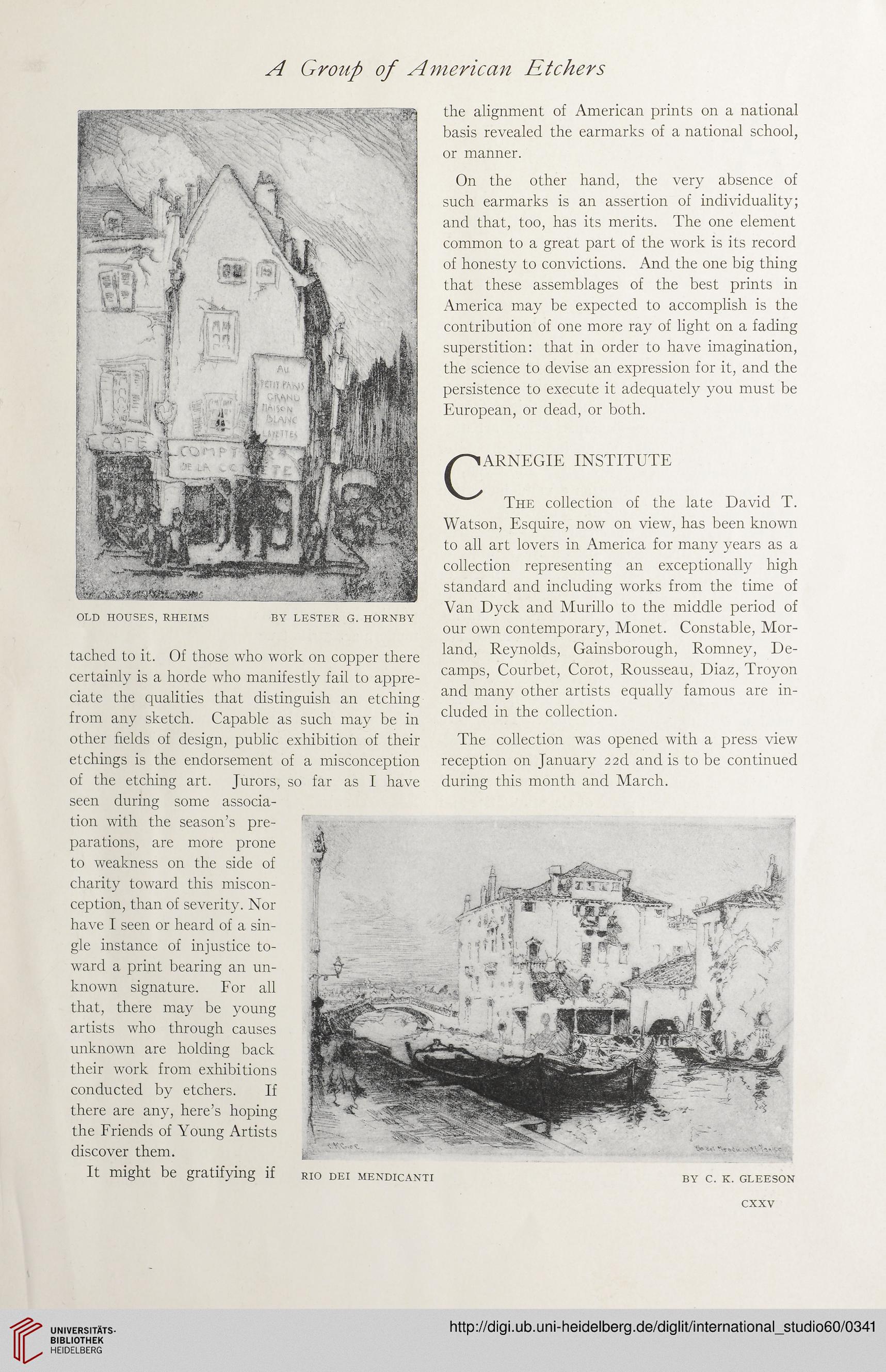A Grottp of American Etchers
OLD HOUSES, RHEIMS
BY LESTER G. HORNBY
the alignment of American prints on a national
basis revealed the earmarks of a national school,
or manner.
On the other hand, the very absence of
such earmarks is an assertion of individuality;
and that, too, has its merits. The one element
common to a great part of the work is its record
of honesty to convictions. And the one big thing
that these assemblages of the best prints in
America may be expected to accomplish is the
contribution of one more ray of light on a fading
superstition: that in order to have imagination,
the science to devise an expression for it, and the
persistence to execute it adequately you must be
European, or dead, or both.
so far as I have
RIO DEI MENDICANTI
tached to it. Of those who work on copper there
certainly is a horde who manifestly fail to appre-
ciate the qualities that distinguish an etching
from any sketch. Capable as such may be in
other fields of design, public exhibition of their
etchings is the endorsement of a misconception
of the etching art. Jurors,
seen during some associa-
tion with the season’s pre-
parations, are more prone
to weakness on the side of
charity toward this miscon-
ception, than of severity. Nor
have I seen or heard of a sin-
gle instance of injustice to¬
ward a print bearing an un-
known signature. For all
that, there may be young
artists who through causes
unknown are holding back
their work from exhibitions
conducted by etchers. If
there are any, here’s hoping
the Friends of Young Artists
discover them.
It might be gratifying if
ARNEGIE INSTITUTE
The collection of the late David T.
Watson, Esquire, now on view, has been known
to all art lovers in America for many years as a
collection representing an exceptionally high
standard and including works from the time of
Van Dyck and Murillo to the middle period of
our own contemporary, Monet. Constable, Mor-
land, Reynolds, Gainsborough, Romney, De-
camps, Courbet, Corot, Rousseau, Diaz, Troyon
and many other artists equally famous are in-
cluded in the collection.
The collection was opened with a press view
reception on January 2 2d and is to be continued
during this month and March.
BY C. K. GLEESON
CXXV
OLD HOUSES, RHEIMS
BY LESTER G. HORNBY
the alignment of American prints on a national
basis revealed the earmarks of a national school,
or manner.
On the other hand, the very absence of
such earmarks is an assertion of individuality;
and that, too, has its merits. The one element
common to a great part of the work is its record
of honesty to convictions. And the one big thing
that these assemblages of the best prints in
America may be expected to accomplish is the
contribution of one more ray of light on a fading
superstition: that in order to have imagination,
the science to devise an expression for it, and the
persistence to execute it adequately you must be
European, or dead, or both.
so far as I have
RIO DEI MENDICANTI
tached to it. Of those who work on copper there
certainly is a horde who manifestly fail to appre-
ciate the qualities that distinguish an etching
from any sketch. Capable as such may be in
other fields of design, public exhibition of their
etchings is the endorsement of a misconception
of the etching art. Jurors,
seen during some associa-
tion with the season’s pre-
parations, are more prone
to weakness on the side of
charity toward this miscon-
ception, than of severity. Nor
have I seen or heard of a sin-
gle instance of injustice to¬
ward a print bearing an un-
known signature. For all
that, there may be young
artists who through causes
unknown are holding back
their work from exhibitions
conducted by etchers. If
there are any, here’s hoping
the Friends of Young Artists
discover them.
It might be gratifying if
ARNEGIE INSTITUTE
The collection of the late David T.
Watson, Esquire, now on view, has been known
to all art lovers in America for many years as a
collection representing an exceptionally high
standard and including works from the time of
Van Dyck and Murillo to the middle period of
our own contemporary, Monet. Constable, Mor-
land, Reynolds, Gainsborough, Romney, De-
camps, Courbet, Corot, Rousseau, Diaz, Troyon
and many other artists equally famous are in-
cluded in the collection.
The collection was opened with a press view
reception on January 2 2d and is to be continued
during this month and March.
BY C. K. GLEESON
CXXV




